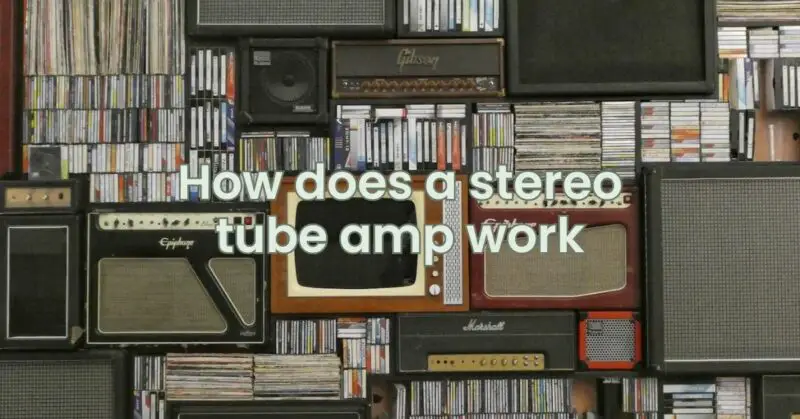In an era dominated by cutting-edge digital audio technology, the warm and nostalgic sound of a stereo tube amp continues to captivate audiophiles and music enthusiasts worldwide. Often associated with vintage charm and musicality, tube amplifiers, also known as valve amplifiers, employ vacuum tubes to amplify audio signals. In this article, we will take a closer look at how a stereo tube amp works, exploring the fundamental principles behind this classic audio amplification technology.
The Basic Components of a Stereo Tube Amp
A stereo tube amp is composed of several essential components, each playing a crucial role in the amplification process. These components include:
- Vacuum Tubes: At the heart of a tube amp are the vacuum tubes or electron tubes. These glass or metal components contain electrodes and a vacuum that allows electrons to flow freely within the tube. The two main types of vacuum tubes used in audio amplification are triodes and pentodes, with triodes being simpler and pentodes providing higher gain.
- Power Transformer: The power transformer is responsible for converting the incoming alternating current (AC) voltage from the wall outlet to the required voltage for the tube amplifier. It supplies the high voltage needed to drive the vacuum tubes and also provides the lower voltages necessary for various circuit components.
- Output Transformer: The output transformer plays a critical role in transferring the amplified audio signals from the tubes to the speakers. It matches the high impedance of the tubes to the low impedance of the speakers, allowing efficient power transfer.
- Signal Input and Output: Stereo tube amps feature input jacks to connect audio sources, such as CD players or turntables, and output jacks to connect to speakers or headphones. The audio signals pass through the tube amp’s circuitry, undergo amplification, and then leave the amp as enhanced signals.
How a Stereo Tube Amp Works
The basic operation of a stereo tube amp can be summarized in the following steps:
- Signal Input: The audio signal from the source, such as a CD player or phonograph, is connected to the input jacks of the stereo tube amp.
- Preamp Stage: The incoming audio signal first enters the preamp stage, which typically contains one or more triode vacuum tubes. In this stage, the signal is amplified to a level sufficient for further processing.
- Tone Control: Some stereo tube amps may include tone control circuits, such as bass and treble knobs, which allow users to adjust the frequency response of the audio signal.
- Power Amp Stage: After passing through the preamp stage, the signal enters the power amp stage, where the more powerful pentode vacuum tubes are commonly used. Here, the signal is further amplified to a level suitable for driving speakers.
- Output Transformer: The amplified audio signal leaves the power amp stage and is transferred to the output transformer. The output transformer matches the high impedance of the tubes to the low impedance of the speakers, efficiently delivering the amplified audio to the speakers.
- Speaker Output: The enhanced audio signal finally reaches the speakers, producing the warm and rich sound characteristic of tube amplifiers.
Advantages of Stereo Tube Amps
The appeal of stereo tube amps lies in their unique sound characteristics and musicality. Some of the advantages include:
- Warm and Harmonic Sound: Tube amplifiers are renowned for their warm and harmonically rich sound, which many find more pleasing and musical than the clean but sometimes sterile sound produced by solid-state amplifiers.
- Natural Compression: Tube amps exhibit a more gradual and smooth compression when driven to their limits, contributing to a forgiving and musical distortion that appeals to many musicians and audiophiles.
- Dynamic Response: Tubes respond differently to changes in volume and audio signals, providing a more dynamic and expressive listening experience.
Conclusion
Despite the proliferation of modern solid-state audio technology, stereo tube amps continue to thrive due to their unique sound qualities and nostalgic appeal. By employing vacuum tubes, power transformers, and output transformers, these classic amplifiers deliver a warm, harmonic, and dynamic sound that resonates with audiophiles seeking an emotional connection to their music.
Whether you are an avid music enthusiast or a professional musician, the allure of a stereo tube amp lies in its ability to transport listeners back to a golden era of audio amplification while providing a timeless and captivating listening experience.


